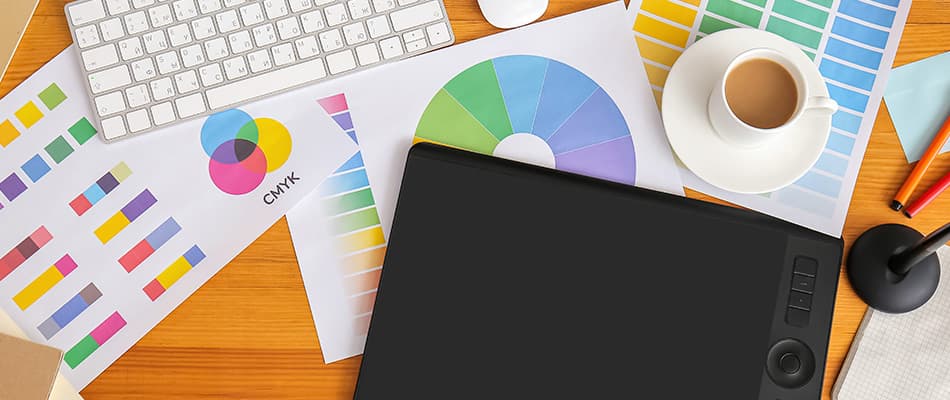What is Colour Theory?- Know Its Principles, Applications, Tools and More!
Colours have a powerful influence on design, emotion, and perception, playing a key role in how messages are conveyed and received. Whether designing a logo, crafting a painting, or building a website, understanding the principles of colour theory is essential for achieving visual harmony and impact.
Colour theory is a foundational guide for creating balanced and appealing colour combinations. It provides tools and frameworks to help artists, designers, and creators select colours that complement each other while evoking specific emotions or responses. Applying these principles allows one to communicate ideas more effectively and create visually engaging designs.
Read the article to learn what colour theory is, its different psychology, principles, and more.
The Basics of Colour Theory
Once you learn ‘what is colour theory’, you can acknowledge its importance in creating visually appealing designs. Understanding how colours interact with each other allows you to evoke specific emotions and guide the viewer’s focus, improving the overall impact of your design. Learn more about the basics of colour theory below:
- The Colour Wheel: A circular diagram showing primary, secondary, and tertiary colours. It helps visualise how colours relate to and contrast with one another.
- Primary Colours: Red, blue, and yellow, which cannot be created by mixing other colours. These are the foundation for all other colours on the wheel.
- Secondary Colours: Green, orange, and purple are made by mixing two primary colours. They create vibrant combinations when paired with primary or tertiary colours.
- Tertiary Colours: Created by mixing a primary colour with a secondary colour. Examples include red-orange, yellow-green, and blue-purple.
- Warm Colours: Red, orange, and yellow, which evoke energy and warmth. These colours are often associated with excitement, action, and passion.
- Cool Colours: Blue, green, and purple, which create calm and soothing effects. They are ideal for promoting relaxation and balance in designs.
- Neutral Colours: Black, white, grey, and brown, often used to balance and complement other colours. These tones provide a subtle background for brighter hues.
Know What Jobs Can I Get With Graphic Design Here
Principles of Colour Theory
When exploring design and visual arts, it is crucial to understand the basic principles that guide colour choices. Once you understand ‘what is colour theory,’ you need to understand its applications for creating visually cohesive designs. The rules of colour theory provide a structured approach to selecting colours that work well together, ensuring balanced and visually appealing outcomes. Let us explore the principles of colour theory below:
1. Colour Harmony
Colour harmony is about arranging colours in a way that looks balanced and appealing. Check its different types below:
- Complementary Colours: Colours opposite each other on the colour wheel (e.g., red and green). These pairings provide strong contrast and make designs visually striking.
- Analogous Colours: Colours next to each other on the wheel (e.g., blue, green, and teal). They are often used to create a serene and comfortable design.
- Triadic Colours: Three evenly spaced colours on the wheel (e.g., red, yellow, and blue). They offer a balance of contrast and harmony in a composition.
2. Colour Contrast
Colour contrast refers to the difference between two colours, influencing readability and emphasis. High contrast, like black and white, makes elements appealing, while low contrast offers a softer, more unified look.
3. Colour Context
Colour context explores how surrounding colours affect the perception of colour. Colours can appear different depending on their background, so understanding this principle helps ensure clarity and visual harmony in designs.
The Psychology of Colour
Understanding the impact of colour on human emotions and behaviour is crucial in design. Once you grasp ‘what is colour theory’, you can explore how different colours evoke specific psychological responses. The psychology of colour helps designers influence mood, create brand identities, and guide user experiences by strategically choosing colours that resonate emotionally. Learn more about the psychology of colour below:
1. Emotional Influence
- Red: Red is often associated with passion, energy, and urgency, creating a sense of excitement.
- Blue: Blue evokes feelings of trust, calmness, and professionalism, making it ideal for corporate branding.
- Green: Green symbolises growth, health, and harmony and is often used in eco-friendly or wellness brands.
- Yellow: Yellow is linked to optimism, creativity, and happiness, commonly used to attract attention and inspire positivity.
2. Use case
Some brands use red to convey energy, excitement, and urgency in their marketing, helping to drive engagement.
3. Cultural Differences
Colours can have varying meanings across cultures. For example, in South Africa and many other African countries, red symbolises strength and vitality, while green represents fertility and the land.
Know What is Concept in Graphic Design Here
Application of Colour Theory in Design
Once you understand what is colour theory and its several applications, you can improve the effectiveness of your design work. The strategic use of colour relationships and emotions can boost the impact of any design, making it aesthetically pleasing and purposeful. Learn more about the application of colour theory below:
1. Graphic Design
- Colour palettes in logos, brochures, and interfaces create strong brand identities and appeal.
- Examples: Google’s colourful logo reflects innovation; Coca-Cola’s red evokes energy; Starbucks’ green symbolises relaxation and sustainability.
2. UI/UX Design
- Colour coding improves usability (e.g., green for success and red for errors).
- Accessibility: High contrast ratios ensure readability while considering colour blindness helps create inclusive designs.
3. Marketing and Advertising
- Colours influence consumer emotions and decisions.
- Examples: Red for urgency (sales), blue for trust (financial services), yellow for optimism (McDonald’s).
- Sale banners often use red for urgency, while blue evokes trust.
Tools to Master Colour Theory
Understanding what is colour theory forms the foundation of effective design. To apply this knowledge practically, designers often rely on tools that assist in selecting and experimenting with colours. These tools help create harmonious colour combinations, ensure proper contrast, and perfect palettes for various design projects. Below are some essential tools to learn colour theory.
- Adobe Color Wheel: A tool that helps designers create colour schemes by exploring different colour harmonies and relationships.
- Coolors: An easy-to-use colour scheme generator that helps you create balanced and visually appealing colour palettes.
- Canva Colour Palette Generator: A free tool that allows you to extract colour palettes from images, helping you match design elements to existing colours.
- Paletton: A colour wheel tool for experimenting with colour schemes and adjusting hues, saturation, and brightness to create harmonious palettes.
- ColourZilla: A browser extension that helps you pick colours directly from web pages and generate colour gradients.
- Color Safe: A tool to create colour schemes that meet accessibility standards, ensuring good contrast ratios for readability.
Why Learn Colour Theory?
Once you understand what is colour theory and its several applications, you can create visually appealing and harmonious branding, art, or digital design compositions. It helps to communicate emotions, establish brand identities, and make designs more effective and impactful, improving your creative work and enhancing user experiences.
- Colour theory helps create visually appealing designs by ensuring harmonious colour combinations.
- It improves emotional impact, enabling you to evoke specific feelings through colours.
- Understanding colour theory improves brand consistency and recognition.
- It enables better decision-making when selecting colours for logos, websites, and marketing materials.
- It helps you create contrast, ensuring important elements stand out clearly.
- Colour theory allows you to effectively convey messages and moods through design.
- It improves your ability to work with different design software and tools efficiently.
- It helps you better understand the cultural significance of colours across different audiences.
Why Choose Digital Regenesys For UI/UX and Graphic Design Course?
Digital Regenesys goes beyond traditional design training. The UI/UX and Graphic Design Course with GenAI by Digital Regenesys offers cutting-edge tools, hands-on experience, and expert insights to equip you with the skills to create impactful designs. Let us know the reasons for choosing this course below.
- Learn to design user-friendly digital products.
- Gain hands-on experience with industry-leading tools.
- Explore generative AI techniques for creative designs.
- Build a strong portfolio with real-world projects.
- Understand what is colour theory.
- Receive career guidance and expert mentoring.
- Access globally recognised certificates upon completion.
- Learn responsive design for mobile and web platforms.
- Develop proficiency in front-end coding languages.
In conclusion, by learning colour principles, designers can evoke emotions, improve brand identity, and communicate effectively through their work. Understanding what is colour theory is also essential for creating visually engaging and impactful designs. Digital Regenesys’s UI/UX and Graphic Design Course provides expert knowledge and hands-on experience with industry tools to create impactful designs. Enrol in the course today and tap into your creative potential.
What is Colour Theory? – FAQs
What is colour theory?
Colour theory is a set of principles that guide the selection of harmonious colour combinations for effective design.
How does colour theory help in design?
It ensures visually appealing and cohesive designs by using colour relationships that evoke specific emotions and responses.
Why is colour theory important for branding?
Colour theory helps create consistent, impactful brand identities by choosing colours that resonate with target audiences.
How can colour theory improve user experience?
It enables the use of intuitive colour coding for better navigation and readability in UI/UX design.
Does Digital Regenesys teach colour theory in its course?
Yes, the UI/UX and Graphic Design Course at Digital Regenesys covers colour theory as part of its curriculum.
How to use colours colour theory?
You can use colours in colour theory by selecting combinations based on colour harmonies (complementary, analogous, triadic) to create visually appealing and emotionally effective designs.














